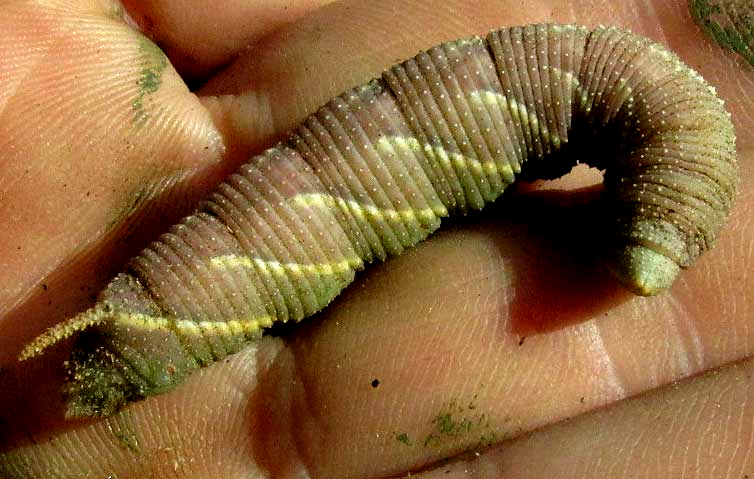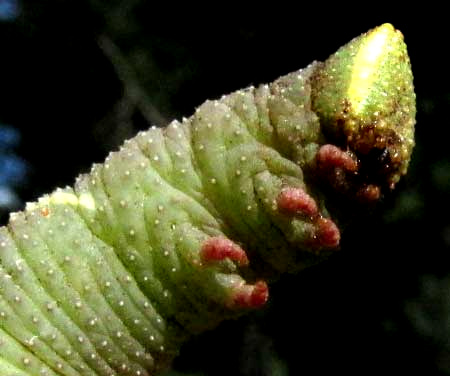Excerpts from Jim Conrad's
Naturalist Newsletter

from the September 7, 2014 Newsletter issued from the Frio Canyon Nature Education Center in the valley of the Dry Frio River in northern Uvalde County, southwestern Texas, on the southern border of the Edwards Plateau; elevation ~1750m (~5750 ft); N29.62°, W99.86°; USA
WALNUT SPHINX HORNWORM
Having photographed the above Tera Sphinx caterpillar I got to work painting a house, but first dirt needed to be pulled away from the foundation. And in the disturbed soil there turned up yet another large, brown hornworm-type caterpillar, but of a different species. That's him in my paint-smeared hand above.
Lots of large, juicy caterpillars of this type display such diagonal lines along their sides, but the many tiny, evenly spaced bumps seemed unusual and therefore good field marks. Another noteworthy feature was the pointy head, shown below:

Several caterpillar species are similar to this one so volunteer identifier Bea in Ontario shipped the pictures to the ButterfliesAndMoths.Org website, where in a few hours an expert had identified it and placed a new on the species' distribution map. The distribution map with our dot -- the southwestern-most large orange one -- can be admired a bit down the page at https://www.butterfliesandmoths.org/species/Amorpha-juglandis.
Our pointy-headed caterpillar studded with tiny bumps is the Walnut Sphinx, AMORPHA JUGLANDIS, which ButterfliesAndMoths.Org says feeds on "Walnut and butternut (Juglans), hickory (Carya), alder (Alnus), beech (Fagus), hazelnut (Corylus), and hop-hornbeam (Ostrya).
None of those host species were nearby where our caterpillar turned up, though here and there Little Walnuts, Juglans microcarpa, are found along the Dry Frio's banks where the river runs through fields of cobblestones. However, big Texas Live Oaks, Quercus fusiformis, shaded the ground where the caterpillar was found, and oaks belong to the same family as beech, where are feed upon, so maybe our Walnut Sphinx caterpillars feed on live oak, too. The adults, by the way, stay alive just long enough to have sex and the female lays eggs, so they have no functional mouthparts. Some sphinx moth species feed as adults while others don't.
Walnut Sphinxes occur throughout eastern US and southernmost Canada though they're absent from most of New England. They also extend into northern Mexico.
I read that Walnut Sphinx caterpillars make a squeaking sound when disturbed, but I heard nothing. Our caterpillar was an excellent squirmer, however, flexing back and forth so violently that the first spasm set off my own involuntary "let-go" response, and I almost dropped him. I bet that most birds with this caterpillar in their beaks would do just that after such a squirm.